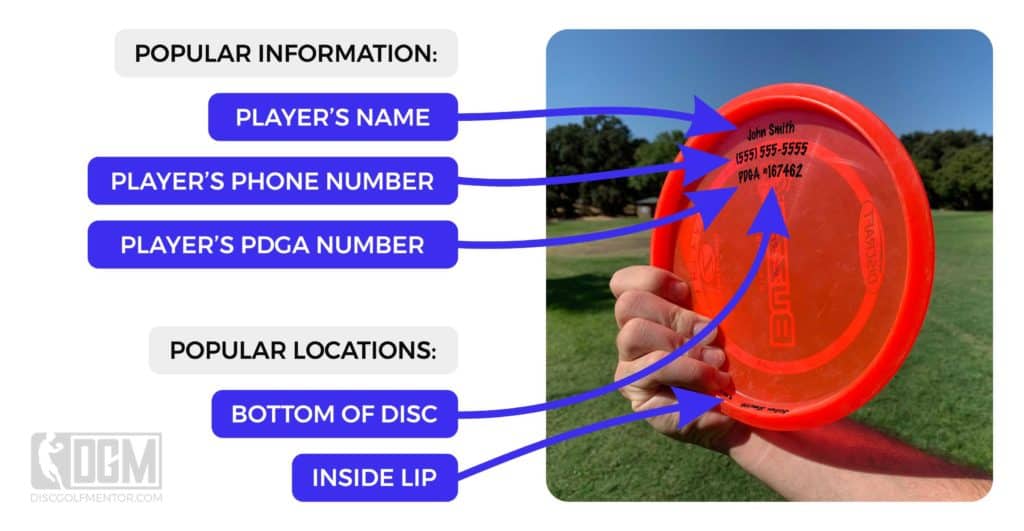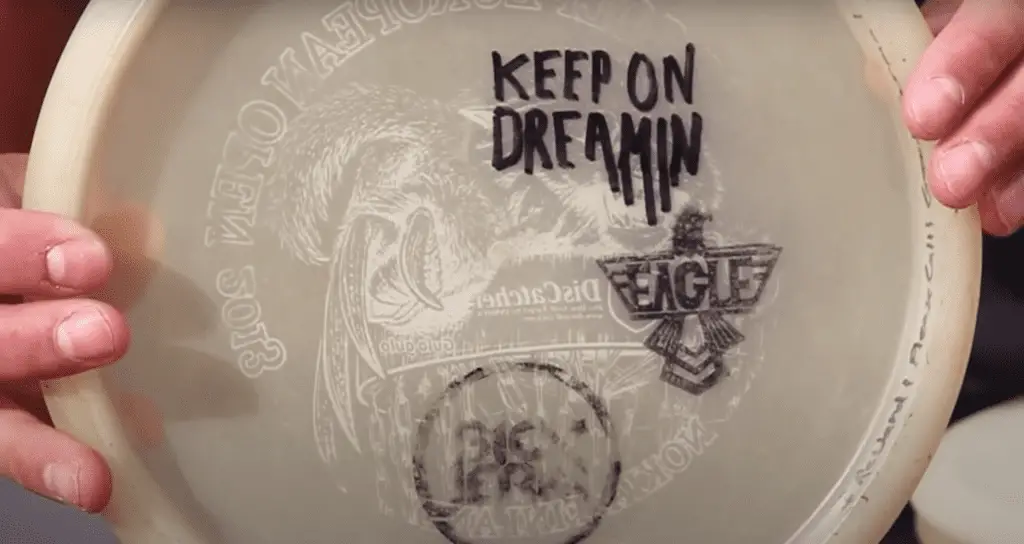Most disc golf players mark their discs simply to let others know that the disc belongs to them but did you know that there’s actually a PDGA rule about unmarked discs? The rule reads:
“All discs used in play, except mini marker discs, must be uniquely marked. A player receives a warning for the first throw of an unmarked disc. A player receives one penalty throw for each subsequent throw of an unmarked disc.”
This is PDGA Official Rule 813.01 and you can find this rule in your PDGA handbook or online.
How to Mark Your Disc
The easiest and most popular way to mark your disc is by writing your name, phone number, and PDGA number (if you have one) on the bottom of the disc with a Sharpie. This helps to distinguish your disc as unique. It also provides contact information so that the disc can be returned to you in case it gets lost.

There are other types of markings and ways to mark your disc however. I’ll go over all the different types so you can decide which works best for you.
Types of Markings
You may be asking, what counts as a mark on your disc golf disc? Technically, any marking that is recognized by the thrower counts, so ultimately it is up to the player.
Some disc golf players put their PDGA number while others put their name or initials. Many players also put their phone number to help aid in returning the disc more quickly if it is ever lost. Again, any marking counts and makes the disc legal during play so a simple signature or even a little drawing such as a smiley face or a star would work as well.
Ways to Mark Your Disc
Permanent Marker
Now that we know what types of markings are acceptable, let us go over the many different ways to actually mark the disc.
We’ll begin with probably the most commonly used method and possibly the easiest method, using a Sharpie marker or any other brand of permanent marker. This method is simple and quick, you can be done in a matter of seconds and it is not hard to store a marker in your disc golf bag or cart for easy access since the marker doesn’t take up much space.
Permanent markers are very cost-effective too, a single marker will last a very long time allowing you to mark many discs over its lifespan and you can find permanent markers in a variety of colors practically at any store. A 2-pack of Sharpies, for example, average around $2.00 at Wal-Mart, Target, Office Depot, and on Amazon. Using a permanent marker is also ideal because the ink doesn’t fade away quickly, and if or when it does fade, you can easily just write over the marking again with a permanent marker.
Stamps
If you want to be unique, you can have a custom stamp created to mark your discs. This is a cool way to personalize your discs because the design can be of your own creation and it will definitely be recognizable among other players.

Pro players Eagle McMahon and Jeremy Koling had a custom stamp made to mark their discs. The process of inking the stamp and pressing it on the disc is relatively quick and you don’t have to worry about misspelling anything. Storage is not as convenient as a permanent marker; you will have to store the stamp and whichever ink pad of your choosing at home because there’s a risk the ink pad opening or the stamp getting damaged if you carry it in your disc golf bag or cart.
The video below show’s Eagle talking about his custom stamp at right around the 12 minute mark. Be sure to check it out.
As far as cost is concerned, it depends on what your budget is. A custom-designed stamp varies in price depending on size and how detailed the design is, and the price of a permanent ink pad also varies depending on size, color, and brand. The stamp will be a one-time purchase unless you want a different design eventually and the ink pad will need to be replaced whenever it runs out.
If you already have a design made, you can get the stamp from www.rubberstamps.com
Labels
Another method of marking a disc is by putting a printed label sticker on it. Labels can be designed however you wish, different colors, fonts, sizes, images, the options are limitless. Labels can be custom ordered and shipped to you or if you have a printer, they can be printed at home whenever you need them.
A sheet or roll of labels will have several on it, so it’s convenient to have multiple labels at a time already available to put on a disc. Labels should probably be stored at home or somewhere where the risk of getting wet and tearing is minimal. The cost will vary depending on if you custom order them or if you print them on your own and you only have to purchase them whenever you run out.
Labels are appealing to players who resell their discs regularly such as a player who is trying to figure out which discs work better for them. The labels can be easily taken off when they are ready to resell and the resale price isn’t affected like it would be if it had permanent ink on it. The downside of labels being easily removable is that unfortunately if the disc is lost on the course and someone else finds it, they can just remove the label and claim it for themselves.
Where to Mark Your Disc
The final step in marking your disc is choosing where to mark it. There is not a rule as to where the mark has to be placed on the disc to make it legal for play. This makes the placement decision entirely up to you and your preference.
To avoid altering the factory stamp on a disc, many players opt for marking the disc on its backside whether it be on the back of the disc or inside the rim.
Many players choose to mark the disc inside the rim for a couple of reasons, it is somewhat a hidden spot so it is less noticeable if they ever choose to resell it or the disc may be a see-through disc and so they want to avoid blocking the view of the stamp. Some players mark the front of the disc because it is easier to see and it’s more recognizable to them.
Why Should I Mark My Disc?
The biggest reason for most recreational players is because discs often become lost. You’re throwing them all over the place in the woods, tall grass, and around water. Losing a disc isn’t really a matter of if, but of when, and when you do, you better hope that you remembered to write your name on it with some sort of contact information.
Now, there’s no guarantee that whoever finds your disc will return it, but they won’t even have a choice if there’s no contact information on it.
“Uniquely Marked”
Another good reason is that you may end up throwing the same disc as another player in your group. Imagine being at a tournament and you have a real shot of winning. Then, you and another player on your card that also has a high chance of winning, happen to throw the same exact disc off the teepad and they land within one foot of each other but one disc is out-of-bounds.
Obviously, you’re hoping that you didn’t throw out-of-bounds but here’s where it gets really tricky, neither of you marked your discs. No one knows for sure which disc belongs to who and that could cost you the tournament, all because the discs weren’t uniquely marked.
A similar situation happened back in 2016 at the PDGA World Championships between professional players Devan Owens, Paul McBeth, and Ricky Wysocki. Defending champion McBeth allegedly overheard Owens say that his discs weren’t marked which led to McBeth alerting the PDGA tournament marshal.
While waiting on a decision to be made regarding Owens’ unmarked discs, Wysocki and Owens happened to throw identical Dynamic Disc Defenders off of Hole 9. Deciding which disc made it farther down the fairway was difficult because neither of the discs were marked.
Ultimately, only warnings were issued but since McBeth warned the marshal prior to the disc being thrown, it could’ve easily resulted in a penalty throw for Owens instead. The whole situation could have been avoided if the players had simply marked their discs.
Wysocki ended up winning the 2016 World Championship but it could’ve ended very differently. For example, if he was caught throwing another unmarked disc it would have resulted in a penalty throw, therefore costing him the championship and McBeth would have won instead. The lesson to be learned is if it can happen among professional players at the World Championships, then it can easily happen at any other tournament with any other player.
Get Your Lost Discs Back!
While marked discs are really important in tournament play for the reasons stated above, that’s not the only reason. Most disc golf players mark their discs so if they get lost in the woods or a water hazard and someone else happens to find the disc later on, they know who it belongs to and it can be returned to its rightful owner.
Let’s say you lose your disc deep in the woods and can’t find it despite searching for 20 minutes. If that disc is unmarked and someone else eventually finds it, then it’s a game of Finders Keepers at that point. They don’t know who the disc belongs to so they can’t return it to you and since its unmarked, anyone can easily claim that it belongs to them.
Wrapping Up
In this article, we learned that for a disc to be legal for play it has to be marked. What method of marking a disc and where the marking is placed is up to the player.
We learned that it’s important to put some sort of identifying mark on your disc because you never know if you and another player could be throwing discs that look exactly the same and you need to be able to tell them apart. It’s also important to have some contact information on your disc in case you lose it (which happens frequently). This way, whoever finds it can return it to you.
We also learned that there are several ways to mark your disc and that the most common way is to simply write your name and phone number on the bottom of the disc in Sharpe. It’s also quite common to list your PDGA number if you have one.
So get out there and have fun! And don’t forget to mark your disc!
